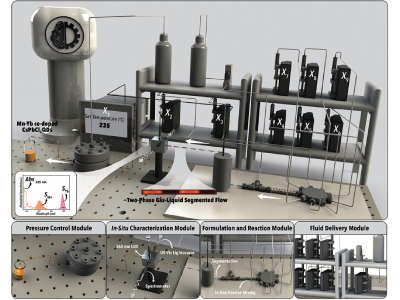
Schematic illustration of Smart Dope's modular hardware, including the fluid delivery, X2-X9, formulation and reaction, in situ characterization, temperature controller, X1, and pressure control modules. Credit: Fazel Bateni et al.
NC State researchers have developed an autonomous system to identify methods for synthesizing best-in-class materials for specific applications in a fraction of the time it would take humans. The system is an autonomous lab that when given precursor chemicals and a designated goal, develops a response in hours.
The new system, called SmartDope, develops optimized methods for material enhancements called perovskite quantum dots via “doping.” “These doped quantum dots are semiconductor nanocrystals that you have introduced specific impurities to in a targeted way, which alters their optical and physicochemical properties,” said Milad Abolhasani, associate professor of chemical engineering at North Carolina State University. “These particular quantum dots are of interest because they hold promise for next generation photovoltaic devices and other photonic and optoelectronic devices,” Abolhasani says. “For example, they could be used to improve the efficiency of solar cells, because they can absorb wavelengths of UV light that solar cells don’t absorb efficiently and convert them into wavelengths of light that solar cells are very efficient at converting into electricity.”
Despite their promising properties, synthesizing these quantum dots is a very time-consuming endeavor. “We had a simple question,” said Abolhasani. “What’s the best possible doped quantum dot for this application? But answering that question using conventional techniques could take 10 years. So, we developed an autonomous lab that allows us to answer that question in hours.”
In the paper, published in Advanced Energy Materials, the researchers describe SmartDope as a “self-driving” lab. Once precursor chemicals and a designated goal are given, the lab autonomously conducts experiments in a continuous flow reactor while manipulating numerous variables until the designated goal is achieved. “As SmartDope collects data on each of its experiments, it uses machine learning to update its understanding of the doped quantum dot synthesis chemistry and inform which experiment to run next, with the goal of making the best quantum dot possible,” Abolhasani says.
“The previous record for quantum yield in this class of doped quantum dots was 130% – meaning the quantum dot emitted 1.3 photons for every photon it absorbed,” Abolhasani says. “Within one day of running SmartDope, we identified a route for synthesizing doped quantum dots that produced a quantum yield of 158%. That’s a significant advance, which would take years to find using traditional experimental techniques. We found a best-in-class solution for this material in one day.
“This work showcases the power of self-driving labs using flow reactors to rapidly find solutions in chemical and material sciences,” Abolhasani says. “We’re currently working on some exciting ways to move this work forward and are also open to working with industry partners.”